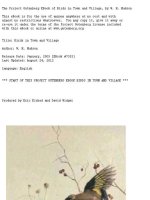The Project Gutenberg EBook of Essays on early ornithology and kindred subjects, by James ppt
Bạn đang xem bản rút gọn của tài liệu. Xem và tải ngay bản đầy đủ của tài liệu tại đây (420.8 KB, 96 trang )
The Project Gutenberg EBook of Essays on
early ornithology and kindred
subjects, by James R. McClymont
This eBook is for the use of anyone
anywhere at no cost and with
almost no restrictions whatsoever. You may
copy it, give it away or
re-use it under the terms of the Project
Gutenberg License included
with this eBook or online at
www.gutenberg.net
Title: Essays on early ornithology and
kindred subjects
Author: James R. McClymont
Release Date: February 4, 2008 [EBook
#24506]
Language: English
*** START OF THIS PROJECT GUTENBERG EBOOK
ESSAYS ON EARLY ORNITHOLOGY ***
Produced by David Wilson and the Online
Distributed
Proofreading Team at
(This file was
produced from images generously made
available by The
Internet Archive/American Libraries.)
ESSAYS ON EARLY
ORNITHOLOGY
200 copies printed
Casuarius uniappendiculatus, juv.
ESSAYS
ON
EARLY
ORNITHOLOGY
AND KINDRED SUBJECTS
BY
JAMES R. McCLYMONT
M.A., AUTHOR OF ‘PEDRALUAREZ CABRAL’
‘VICENTE AÑES PINÇON’
WITH THREE PLATES
LONDON
BERNARD QUARITCH LTD.
11 GRAFTON STREET, NEW BOND STREET
1920
CONTENTS
PAGE
The Rukh of Marco Polo
3
The Penguins and the Seals of
the Angra de Sam Bràs
7
The Banda Islands and the
Bandan Birds
15
The Etymology of the Name
‘Emu’
21
Australian Birds in 1697
25
New Zealand Birds in 1772
31
LIST OF PLATES
I. Casuarius
uniappendiculatus,
Blyth. (juv.).
From an example
in the British
Museum of
Natural History.
By permission of
the Director.
Frontispiece
This plate should be
compared with that
opposite p. 22, which
represents a cassowary
with two wattles—
probably an immature
Casuarius galeatus,
Vieill. for that is the
species which is
believed to have been
brought alive to
Europe by the Dutch in
1597. An immature
example of that species
was not available for
reproduction.
II. Abris des wvnderbaren
Vogels Eme. From
the fifth edition of
Erste Schiffart in
die orientalische
Indien so die
holländische
Schiff im Martio
1595 aussgefahren
vnd im Augusto
1597
wiederkommen
verzicht … Durch
Levinvm Hvlsivm.
Editio Quinta.
Getruckt zu
Franckfurt am
Mäyn durch
Hartmann
Palthenium in
Verlegung der
Hulfischen. Anno
M.DC.xxv. , From
a copy of the
book in the
British Museum.
By permission of
the Keeper of
Printed Books.
p. 22
III. The Masked or Blue-
faced Gannet
(Sula cyanops, S.
personata) . From
an example in the
Royal Scottish
Museum. By
permission of the
Director.
p. 35
In the Manuel d’Ornithologie
(1828) Lesson writes:
‘Le Fou Manche de
Velours, “manga de
velado” des
navigateurs portugais,
que l’on dit être le fou
de Bassan, est de
moitié plus petit. Ce
serait donc une race
distincte.’ tom. II.
p. 375. And in the
Traité d’Ornithologie
the same author
amplifies thus what he
has written: ‘Fou
Manche de Velours;
Sula dactylatra, Less.
Zool. de la Coq., Texte,
part. 2, p. 494. Espèce
confondue avec le fou
de Bassan adulte; est
le manga de Velado
des Portugais.
Plumage blanc pur;
ailes et queue noires;
bec corné; tarses
jaunes; la base du bec
cerclée d’une peau
nue, qui s’étend sur la
gorge en forme de
demi-cercle. Femelle:
Grise. L’île de
l’Ascension, les mers
chaudes des
Tropiques.’ Texte,
p. 601.
M
THE RUKH OF
MARCO POLO
CONTENTS
ARCO POLO, had he confined
himself to a sober narration of his
travels, would have left to posterity a
valuable record of the political
institutions and national customs of the
peoples of his day in the Far East. He was
not satisfied with doing this, but added to
his narrative a number of on-dit more or
less marvellous in character, which he
collected from credulous or inventive
persons with whom he came into contact,
principally from mariners and from other
travellers.
Of these addenda to his story not one is
more incredible than that of the rukh, and
yet that addendum may be regarded as
indicating the transition from the utterly
incredible to the admixture of truth with
fiction in bird-lore. For, whilst the rukh
possessed some characteristics which are
utterly fabulous, others are credible
enough. We are told, for example, that it
resembled an eagle, that it was
carnivorous, that it possessed remarkable
powers of flight, and that it visited islands
which lay to the south of Zanzibar, within
the influence of an ocean current which
rendered difficult or impossible a voyage
from these regions to India, and which
therefore must have tended in a southerly
direction. In this current we have no
difficulty in recognising that of
Mozambique. On the other hand, that the
rukh had an expanse of wing of thirty
paces, and that it could lift an elephant in
its talons, are of course utterly incredible
assertions.
The rukh therefore holds a position in
bird-lore intermediate between that of the
phœnix and that of the pelican fed upon
the blood of its mother whose beak is
tipped with red, or that of the barnacle
goose, of which the name suggests the
mollusc,1 the barnacle, and which was
said to proceed from the mollusc or that of
the bird of paradise, the feet of which
were cut off by the Malay traders who
sold the skins, and which were commonly
reported never to have had feet, but to
float perpetually in the air.
Thus two streams united into one floated
the conception of the rukh—a
mythological stream taking its rise from
the simourgh of the Persians and a stream
of fact taking its rise in the observation of
a real bird which visited certain islands
off the south-east coast of Africa, and
which is said to have resembled an eagle
and may have been a sea-eagle. With
commendable reticence lexicographers
tell us that ‘rukh’ was the name of a bird
of mighty wing.
1 I.e., a fabulous mollusc; the barnacle is not now
regarded as a mollusc.
T
THE PENGUINS AND THE
SEALS
OF THE
ANGRA DE SAM BRÀS
CONTENTS
HERE exists an anonymous narrative
of the first voyage of Vasco da Gama
to India under the title Roteiro da Viagem
de Vasco da Gama em MCCCCXCVII .
Although it is called a roteiro, it is in fact
a purely personal and popular account of
the voyage, and does not contain either
sailing directions or a systematic
description of all the ports which were
visited, as one might expect in a roteiro.
There is no reason to believe that it was
written by Vasco da Gama. An officer in
such high authority would not be likely to
write his narrative anonymously. The
faulty and variable orthography of the
roteiro also renders improbable the
hypothesis that Vasco da Gama was the
author.
The journal of the first voyage of
Columbus contains many allusions to the
birds which were seen in the course of it
by the great discoverer. In this respect the
roteiro of the first voyage of Vasco da
Gama resembles it. The journal of
Columbus is the earliest record of an
important voyage of discovery which
recognises natural history as an aid to
navigators, the roteiro is the next.
The author of the roteiro notes that birds
resembling large herons were seen in the
month of August, 1497, at which time, I
opine, the vessels of Da Gama were not
far from the Gulf of Guinea, or were,
perhaps, making their way across that gulf.
On the 27th of October, as the vessels
approached the south-west coast of
Africa, whales and seals were
encountered, and also ‘quoquas.’
‘Quoquas’ is the first example of the
eccentric orthography of our author.
‘Quoquas’ is, no doubt, his manner of
writing ‘conchas,’ that is to say ‘shells’;
the til over the o is absent; perhaps that is
a typographical error; probably the author
wrote or intended to write quõquas. These
shells may have been those of nautili.
On the 8th of November the vessels under
the command of Vasco da Gama cast
anchor in a wide bay which extended from
east to west, and which was sheltered
from all winds excepting that which blew
from the north-west. It was subsequently
estimated that this anchorage was sixty
leagues distant from the Angra de Sam
Bràs; and as the Angra de Sam Bràs was
estimated to be sixty leagues distant from
the Cape of Good Hope, the sheltered
anchorage must have been in proximity to
the Cape.
The voyagers named it the Angra de Santa
Elena, and it may have been the bay which
is now known as St. Helen’s Bay. But it is
worthy of note that the G. de Sta. Ellena of
the Cantino Chart is laid down in a
position which corresponds rather with
that of Table Bay than with that of St.
Helen’s Bay.
The Portuguese came into contact with the
inhabitants of the country adjacent to the
anchorage. These people had tawny
complexions, and carried wooden spears
tipped with horn—assagais of a kind—
and bows and arrows. They also used
foxes’ tails attached to short wooden
handles. We are not informed for what
purposes the foxes’ tails were used. Were
they used to brush flies away, or were
they insignia of authority? The food of the
natives was the flesh of whales, seals, and
antelopes (gazellas), and the roots of
certain plants. Crayfish or ‘Cape lobsters’
abounded near the anchorage.
The author of the roteiro affirms that the
birds of the country resembled the birds in
Portugal, and that amongst them were
cormorants, larks, turtle-doves, and gulls.
The gulls are called ‘guayvotas,’ but
‘guayvotas’ is probably another instance
of the eccentric orthography of the author
and equivalent to ‘gaivotas.’
In December the squadron reached the
Angra de São Bràs, which was either
Mossel Bay or another bay in close
proximity to Mossel Bay. Here penguins
and seals were in great abundance. The
author of the roteiro calls the penguins
‘sotelycairos,’ which is more correctly
written ‘sotilicarios’ by subsequent
writers. The word is probably related to
the Spanish sotil and the Latin subtilis,
and may contain an allusion to the
supposed cunning of the penguins, which
disappear by diving when an enemy
approaches.
The sotilicarios, says the chronicler,
could not fly because there were no quill-
feathers in their wings; in size they were
as large as drakes, and their cry
resembled the braying of an ass.
Castanheda, Goes, and Osorio also
mention the sotilicario in their accounts of
the first voyage of Vasco da Gama, and
compare its flipper to the wing of a bat—a









